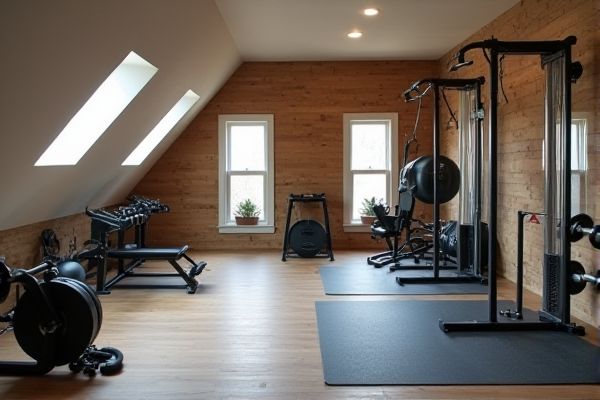
Choosing between an attic exercise room and a basement gym hinges on factors like space availability, natural light, and ventilation, where attics often provide brighter, more inviting workout environments, while basements typically offer cooler temperatures and more consistent flooring. Explore this article to discover which option best fits your fitness needs and home layout.
Table of Comparison
| Feature | Attic Exercise Room | Basement Gym |
|---|---|---|
| Space Availability | Limited due to sloped ceilings, smaller area | Typically larger, open layout for various equipment |
| Temperature Control | Warmer in summer, colder in winter without insulation | Consistent cooler temperature, easier to insulate |
| Humidity Levels | Lower risk of moisture, usually dry | Higher risk of dampness and mold, requires dehumidifier |
| Lighting | Natural light from skylights or small windows | Limited natural light, depends on small or no windows |
| Accessibility | Requires stairs, can be inconvenient | Easier access, usually ground level or one flight down |
| Noise Impact | Less noise disturbance to main living areas | Noise can travel to main floor, may need soundproofing |
| Equipment Options | Best for small or compact equipment due to space limits | Suitable for heavy and large equipment like treadmills and weights |
| Installation Cost | Moderate, costs for insulation and ventilation | Potentially higher, may require moisture barriers and HVAC |
Attic Exercise Room vs Basement Gym: Key Differences
An attic exercise room offers natural light and improved ventilation, creating a more inviting workout environment, whereas a basement gym typically provides consistent temperature control and more space for larger equipment. Attics may require structural assessment for weight support, while basements often offer higher ceiling clearance and sound insulation to contain noise. Your choice depends on factors like equipment size, lighting preference, and potential renovation costs.
Space Utilization: Attic vs Basement for Home Fitness
Attics often provide cozy, well-lit spaces with sloped ceilings that can limit equipment size but encourage creative layouts for home fitness, while basements typically offer larger, open areas with higher ceilings ideal for bulky machines and diverse workout zones. Ventilation and natural light in attics enhance workout comfort, contrasting with basement gyms that may require additional lighting and moisture control to maintain equipment and air quality. Selecting between attic exercise rooms and basement gyms depends on ceiling height, square footage, and environmental conditions to optimize space utilization for effective home workouts.
Ceiling Height and Headroom Considerations
Attic exercise rooms often face limitations in ceiling height, typically ranging from 7 to 8 feet, which can restrict certain workout movements and equipment placement. Basement gyms usually offer higher ceilings, often exceeding 8 feet, providing more headroom for exercises like jumping or overhead lifts. Assessing the ceiling height in your chosen space ensures comfortable headroom and accommodates your fitness routine effectively.
Natural Light and Ventilation Comparison
An attic exercise room often benefits from skylights and dormer windows, providing abundant natural light and improved ventilation through roof vents and operable windows. In contrast, basement gyms typically face challenges with limited natural light, relying on small windows or light wells, and require mechanical ventilation systems to maintain air quality. Proper ventilation in both spaces is crucial to prevent moisture buildup and ensure a comfortable workout environment.
Noise Control and Privacy Factors
Attic exercise rooms offer superior noise control due to their distance from main living areas, reducing sound transmission and ensuring your workouts remain private. Basements, while spacious, often share walls with utility spaces and neighboring units, which can amplify noise and compromise privacy. Choosing your attic for an exercise room minimizes disturbances and provides a quieter, more private environment for your fitness routine.
Temperature and Climate Management
An attic exercise room often experiences higher temperatures and greater climate fluctuations due to its proximity to the roof and lack of insulation, making temperature control a challenge during summer and winter. In contrast, basement gyms typically maintain a more consistent and cooler climate, benefiting from underground insulation and natural earth temperature regulation. Proper ventilation and climate control systems are essential in both spaces to ensure a comfortable and safe workout environment.
Equipment Options: Attic or Basement Suitability
Attic exercise rooms often have height and ventilation limitations, making equipment like treadmills or ellipticals less suitable, while lighter machines such as yoga mats, dumbbells, or resistance bands work well. Basement gyms typically provide more space and stable climate control, allowing for heavier equipment like weight benches, squat racks, and stationary bikes without structural constraints. Your choice depends on the specific equipment you want to use and the space's ability to accommodate weight, ceiling height, and airflow needs.
Accessibility and Convenience: Which Wins?
An attic exercise room offers privacy and quiet, ideal for focused workouts, but may pose challenges due to stairs and limited access, especially with heavy equipment. A basement gym typically provides easier entry from the main floor and ample space for versatile setups, enhancing your workout convenience. Choosing between them depends on how important ease of access is compared to seclusion in your exercise routine.
Renovation and Cost Implications
Renovating an attic exercise room often involves addressing insulation, ventilation, and structural support, which can increase costs due to the space's typical limitations and accessibility challenges. Basement gyms generally require moisture control, adequate lighting, and potential waterproofing, leading to potentially higher expenses related to damp-proofing and HVAC installation. Budget considerations should weigh the specific renovation requirements of each space, with attic conversions often demanding more significant structural modifications compared to basement adaptations.
Safety Concerns and Structural Support
Attic exercise rooms require careful assessment of structural support, as floor joists may need reinforcement to safely handle heavy gym equipment and vigorous workouts. Basements generally offer stronger foundations and more stable flooring, reducing the risk of injuries caused by structural weaknesses. Ensuring proper ventilation and emergency exits is crucial for both spaces to maintain safety standards during your exercise routines.
 homyna.com
homyna.com